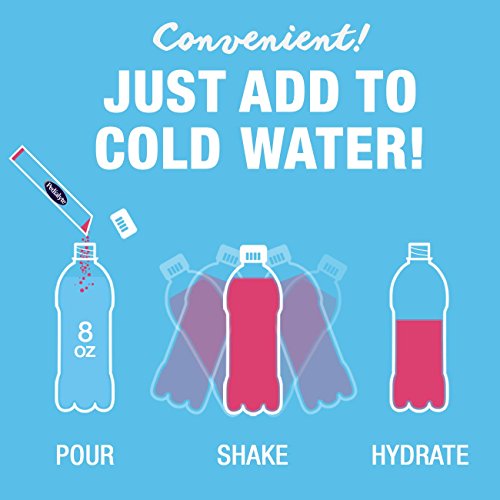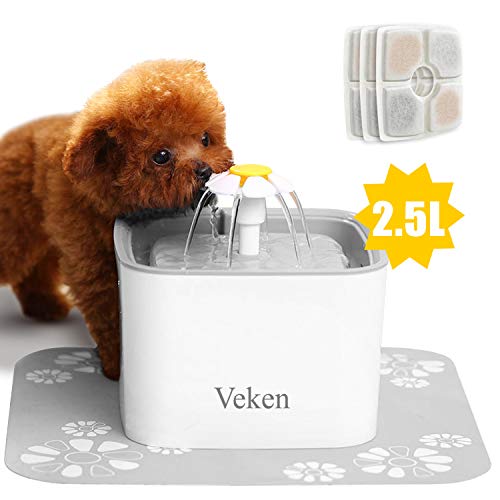
If your dog has been showing signs of dehydration, you’ve probably considered giving your dog Pedialyte. You’ve probably also wondered if Pedialyte is okay to give a dog. And if Pedialyte is okay, then just how much Pedialyte for a dog is safe? What dosage of Pedialyte is safe for your dog and okay to treat dehydration?
Because we’ve got a lot to talk about, we will go straight into our article for today. Let’s begin.
Table of Contents
What Is Pedialyte?
Pedialyte is a drink that’s designed to replace needed electrolytes in the body while helping said body recover from dehydration and sickness. Some of these electrolytes include Zinc, Potassium, and Sodium.
Pedialyte stands out from other similar drinks because it has a higher concentration of electrolytes but a significantly lower concentration of sugar. This isn’t the case with most traditional sport drinks like Gatorade.
So, for humans and dogs alike, Pedialyte seems to be a better option than Gatorade which has just as much sugar (or even more sugar) than soda.
Pedialyte contains no sucrose at all unlike most popular sports drinks you know. This is great because sucrose is known to draw in electrolytes and fluids into the intestine which causes further dehydration.
Pedialyte comes in different forms including powdered (you mix this yourself in water), premixed, and the freezer pops.
[amalinkspro type=”showcase” asin=”B000ARPKB2″ apilink=”https://www.amazon.com/dp/B000ARPKB2?tag=dpg-amalinks03-20&linkCode=osi&th=1&psc=1″ new-window=”true” addtocart=”true” nofollow=”true” sc-id=”4″ imgs=”LargeImage” link-imgs=”false” specs=”Replaces Electrolytes: A Flavorful Way for Kids and Adults to Replace Electrolytes to Feel Better Fast.~~~More Effective than Common Beverages: Designed to Replace Fluids and Electrolytes More Effectively than Sports Drinks, Pedialyte Provides an Optimal Balance of Sugar and Electrolytes to Prevent Mild to Moderate Dehydration. It’s Medical-Grade Hydrat~~~Trusted Brand: #1 Pediatrician and Pharmacist-Recommended Brand. For over 50 Years, Pedialyte Has Been the Go-To Rehydration Drink (Among Pediatricians and Pharmacists Surveyed, Respectively (2017). Data on File with Manufacturer).~~~GREAT-TASTING FLAVORS: Enjoy Pedialyte liters, powder packs, and freezer pops in 17 refreshing flavors.~~~Pour & Hydrate: Tastes Best Served Chilled. To Maintain Proper Hydration, 1–2 Liters of Pedialyte May Be Needed per Day.~~~” btn-color=”#ff9900″ btn-text=”View on Amazon” alignment=”aligncenter” hide-prime=”0″ hide-image=”0″ hide-reviews=”0″ hide-price=”1″ hide-button=”0″ width=”750″]Pedialyte Electrolyte Solution, Hydration Drink, 1 Liter, 8 Count, Unflavored[/amalinkspro]
Produced by the Abbott Laboratories, Pedialyte was first distributed in 1966 in the US. The first time it was introduced, the drink was sold as a ready-made rehydration solution but specifically for children. However, over time, Pedialyte began to be used by adults as well and proved very effective too.
When it comes to rehydrating your dog or humans, experts say Pedialyte is a much better and much healthier alternative than sports drinks or even water as it is high in electrolytes and low in sugar.
Plain water contains no electrolyte to replace the lost electrolytes that occur as a result of dehydrating, and other sport drinks contain too much sugar which inhibit the absorption of the needed electrolytes.
Should I Give My Dog Pedialyte?
Generally, Pedialyte is safe for dogs as 65% of dogs take to a Pedialyte treatment well. However, the other 35% who do not have to resort to IV treatment instead.
Usually, if a dog is going through a bout of diarrhea and vomiting, your vet might recommend Pedialyte for your dog.
Now, please, bear in mind that Pedialyte wasn’t made with dogs in mind. Nonetheless, it has proven to be effective in the treatment of mild to moderate dehydration in dogs. This has been studied and confirmed to be safe and effective for dogs. The problem only arises if your dog is not accepting treatment.
When Should You Give Your Dog Pedialyte?
Experts advise that you give your dog Pedialyte the moment you notice your dog is dehydrating. However, be careful not to give your dog Pedialyte if your dog is vomiting severely.
If your dog is having difficulties keeping his food and drink down, then giving him Pedialyte might make things somewhat worse for your dog as he will, most likely, vomit even more.
If your dog is vomiting seriously, the best thing to do is to consult your vet immediately.
That said, here are some red flags you might notice in your dog that tells you he might need Pedialyte.
- Panting excessively.
- Sluggish and lethargic movement.
- Hollow eyes.
- Dry skin around the nose, mouth, and eyes.
- Not eating or drinking as usual. If this has happened for longer than 24 hours at a stretch, then your dog is already severely dehydrated.
When you notice any of these symptoms, it’s best to call your vet immediately. Sometimes, they might tell you that your dog simply needs some Pedialyte and he’ll be fine. In more severe cases though, your furry baby might require a more serious treatment regimen.
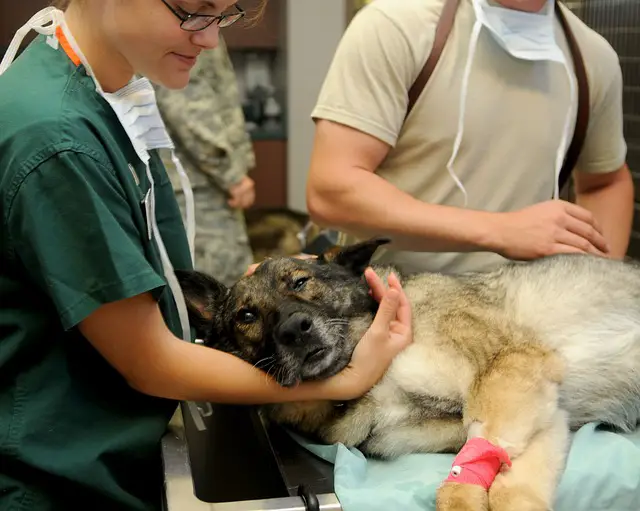
How Pedialyte Works
Just like most rehydration drinks, Pedialyte contains a mix of sodium and sugar. Together, the sodium and sugar are transported through the small intestine. The glucose (sugar) in Pedialyte helps the absorption of water and sodium ions in the small intestine which is important for your dog’s recovery process.
Nonetheless, it is important to ensure that your dog is properly diagnosed if he is dehydrating.
How To Administer Pedialyte To Your Dog
Pedialyte is usually administered in liquid form, and there’s the powdered and liquid form. The liquid form is the most commonly used form as it is easier to use since it’s ready to drink right out of the bottle. No preparation required.
Powder, on the other hand, is not as convenient. Nonetheless, it also comes in handy sometimes as it lasts longer and can easily be made into a drink whenever needed.
[amalinkspro type=”cta-btn-css” ctabtn-id=”” asin=”B004M1BOC6″ apilink=”https://www.amazon.com/dp/B004M1BOC6?tag=dpg-amalinks03-20&linkCode=osi&th=1&psc=1″ addtocart=”true” new-window=”true” nofollow=”true” alignment=”alignright”]Buy on Amazon[/amalinkspro]
By the way, when mixing Pedialyte in water, you want to mix 1 part of Pedialyte into 1 part of water.
So, how do you administer Pedialyte to a dog?
- You can give it to your dog through a bottle.
- You can mix the powdered Pedialyte into your dog’s drinking bowl.
- Syringes can also be used if your dog is having a hard time taking it on his own.
Please note that Pedialyte comes in two options — the flavored and unflavored options. It’s better to go for the unflavored Pedialyte as it’s less likely to give your dog allergies. Flavored Pedialyte contains various kinds of coloring agents which can give your dog allergies. So, it’s best to stick with unflavored Pedialyte.
How Much Pedialyte For A Dog?
For Adult Dogs
For an adult dog, administer about 10 to 15 milliliters of Pedialyte per pound of dog weight. You can either measure this using a measuring cup or a syringe. It must not be super accurate but make sure you’re as close to the dosage as possible.
This is the usual dose for an adult dog. However, if your dog is severely dehydrated, then you can give your dog a little more Pedialyte.
Generally, Pedialyte is safe for dogs, it still contains sugar as well as electrolytes like potassium. And if taken in excess, it could cause unpleasant side effects afterward. This is why you must stick to a safe dosage for your dog.
For A 10-Pound Dog
For a 10-pound dog, a dosage of 100 milliliters to 150 milliliters of Pedialyte should be enough.
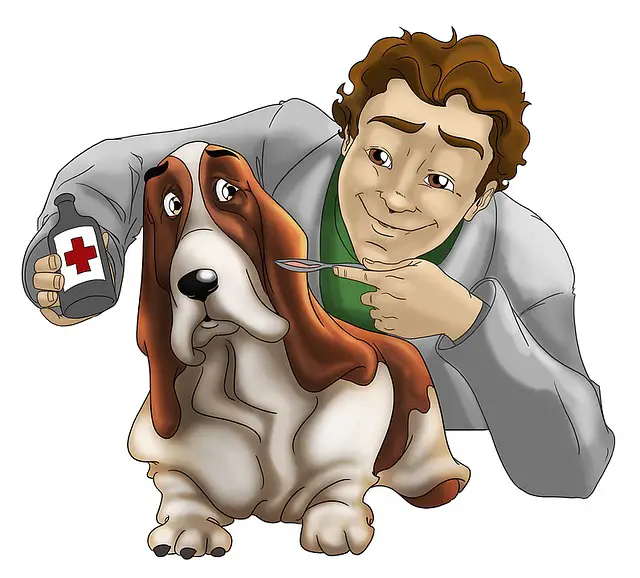
For A Puppy
If it’s your puppy that is dehydrated to the point of needing Pedialyte, then the best thing to do is to consult your vet first. They will confirm what exactly is causing dehydration in your puppy and then give their recommendation.
Generally, for puppies, Pedialyte is okay as long as it is administered in safe doses.
For puppies, the best way to administer Pedialyte is via syringe. And then you administer it to your dog in small doses over an hour’s time. You don’t want to bombard their system with a huge dose of Pedialyte all at once.
So, in general, for puppies, aim for about 10 milliliters to 15 milliliters of Pedialyte over a one-hour period.
Learn more about how to care for a dog who’s losing nutrients due to vomiting or sickness.
Dehydration In Dogs — How To Tell If Your Dog Is Dehydrating (And Needs Pedialyte)
Dehydration often results when a dog has been vomiting or having diarrhea. Other times, it might be caused by a virus or as a result of poor fluid intake in the case of a fever, heat stroke, or a serious illness.
To learn more about the devastating effects of overheating in dogs, click here to read our article: When Is It Too Hot To Walk Your Dog?
Knowing when your dog is dehydrating is very important in order to make a fast response that could, in many cases, be what saves your dog’s life.
A dog’s body is made up of 60% water. This water plays a pivotal role in the dissolving of foods and the flushing of toxins.
Many times, a small drop in water levels is enough to bring on a barrage of symptoms including a buildup of toxins that could damage some organs. In some cases, this damage can become permanent if not treated.
Generally, the symptoms of dehydration in dogs will vary according to how severe or otherwise the dehydration has gotten to.
Mild Dehydration
- Weakness and lethargy.
- Excessive panting.
- Depression.
- Eyes appear somewhat sunken.
- Dry nose, gums, and mouth.
Moderate Dehydration
- Skin tenting.
- Fever.
- Capillary refill time appears delayed.
Severe Dehydration
- Dog appears extremely weak and unsteady.

As dehydration becomes worse, a dog might begin to lose moistness in his gums and the gums also begin to appear dry and sticky. Eyes could also get sunken and the dog might even collapse in shock.
For dehydration, therefore, the best way to handle this is early intervention. Oftentimes, by the time it gets to the severe stage, a lot of damage has already been done. Intervening early will keep things from spiraling out of control.
How To Test Your Dog To See If He Is Dehydrated
Here are the two main methods to do test if to see if your dog is dehydrated:
- Skin Tenting
- Capillary Refill Test
1. Skin Tenting
In the skin tenting test, you’re measuring the elasticity of your dog’s skin which is a great indicator of hydration levels. Do this by pinching an area of your dog’s skin around his shoulder blades and pulling it up. When you release the skin, it’s supposed to return to its original shape.
However, if a dog is dehydrated, it would take a longer time for the skin to return to its original shape indicating poor elasticity. When the skin remains tented rather than popping back in place, then your dog is definitely severely dehydrated.
2. Capillary Refill Test
This is a test to find out how fast the blood returns to the capillaries. If the blood is slow in returning to the capillary, then the patient is dehydrated.
So, how do you carry out this test? Simply press against the gum line. This should turn the pink capillaries white as the blood squishes out of the capillaries. When you release your finger, naturally, blood will return. If that takes longer 1.5 seconds, it’s abnormal and might be indicative that your dog is dehydrated.
Watch the video below to learn more about how to tell when your dog is dehydrated.
Other Medical Conditions Where Dogs Need Pedialyte and How Much Pedialyte To Give
How Much Pedialyte For A Dog With Parvo?
You can begin with 15 milliliters to 20 milliliters and administer that slowly over a period of one hour. Then you can do that for about three to four times in 24 hours making sure the intervals between each administration are evenly spaced out.
The generally accepted dose of Pedialyte in dogs is about 10 milliliters to 15 milliliters. However, the reason we’ve recommended that you administer a little more than the normal dosage is because parvo is pretty serious and causes severe dehydration.
Parvovirus (also called Parvo) is a deadly virus that causes a lot of symptoms in its host including bloody diarrhea, severe vomiting, lethargy, and dehydration as well.
Usually, this virus is contracted by puppies mostly between the ages of 6 weeks and 12 weeks, most especially in puppies that haven’t been vaccinated yet. Dehydration is even worse in puppies as they generally combat poorly with it when compared with adult dogs.
Pedialyte is great because it rehydrates the patient without giving any dangerous side effects. But just how much Pedialyte should you give a dog with Parvo?
In the end, this is strictly for educational purposes. If your dog has Parvo, it is a serious infection and should be treated as such. Please consult your vet immediately.
How Much Pedialyte For A Dog With Kidney Disease?
Simply administer Pedialyte in small amounts at a time but often enough during the day.
Dogs with kidney diseases tend to battle with dehydration much more and more often than dogs without kidney diseases. By administering Pedialyte to a dog with kidney disease, you can actually help your dog stay hydrated.
However, if your dog has chronic kidney disease and it has gotten to the advanced stage you might have to consult with your vet first before administering Pedialyte. Pedialyte contains potassium and dogs with advanced chronic kidney diseases generally find it harder getting rid of excess potassium when compared to healthy dogs.
How Much Pedialyte For A Dog With Pancreatitis?
For dogs with pancreatitis, giving them small amounts of Pedialyte often enough throughout the day should be just fine. It helps relieve the dehydration that comes from vomiting and hormonal imbalance.
Dogs with pancreatitis typically experience symptoms such as pains and vomiting regardless of whether the condition is an acute one or a chronic one. And Pedialyte is a pretty good remedy.
With the extra minerals and electrolytes in Pedialyte, your dog can pull through pancreatitis and its effects a lot better. As always, please consult your vet when treating your dog with Pedialyte.
How Much Pedialyte For A Dog With Bladder Stones?
For dogs with bladder stones, you’d have to be careful. Occasional sips of Pedialyte is definitely great. However, Pedialyte has a high level of sodium, so you don’t want to give your dog too much of it if he has bladder stones.
Now, while this depends on what the cause of the bladder stones is (and it can be caused by a number of things), it’s still best to be careful. Also, please consult your vet before when deciding on Pedialyte for dogs with bladder stones.
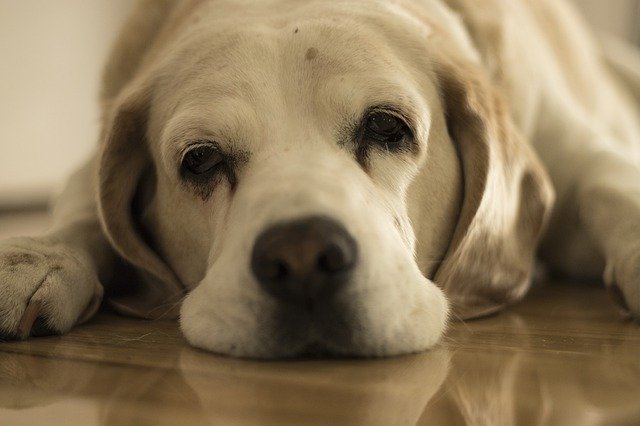
When Pedialyte Is Bad For A Dog
If your dog is not exactly sick, don’t administer Pedialyte. Some dog owners do this believing it’s healthy but it’s not. They are simply flooding their dog’s body with excess electrolytes that the body does not need. Plus, you could raise the sodium levels in your dog’s body to dangerous levels. You don’t want that.
Check out these other articles:
- 197 Foods Dogs Can’t Eat — The Ultimate Guide
- Dog Seperation Anxiety — Causes, Prevention, Symptoms, Treatment
- How Long Does It Take For A Dog To Digest Food?
- My Dog Ate Chicken Bones, What Do I Do?
- How To Get A Dog To Eat
- How Do I Know If My Dog Has Mange?
How To Keep Your Dog From Dehydrating
How can you prevent your dog from getting dehydrated?
1. Provide The Dog With Enough Water
Make sure that your dog always has access to enough water all through the day except you’re still potty training or health conditions suggest otherwise.
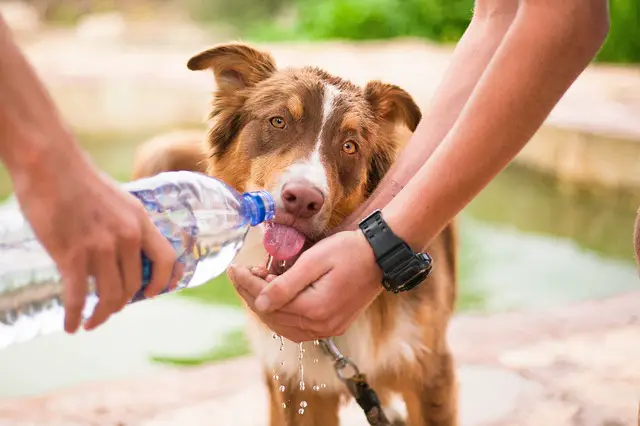
2. Consider Dog Water Fountains
If your dog isn’t drinking as much even though you’re making water available to them all day, it’s possible they aren’t drinking because the water isn’t fresh.
Consider changing your dog’s water regularly or getting a dog fountain or an automatic waterer. It will provide a steady stream of fresh water for your dog to drink. There are pets that are so picky as to only drink fresh water, and not stagnant water.
3. Include Breaks In Your Dog’s Schedule
Include frequent breaks in your dog’s schedule for him to exercise, play, and take some water, especially during the heat.
4. Observe Your Dog When He’s Ill
If your dog is vomiting and having diarrhea, then observe him and report to your vet as soon as possible.
5. Administer Pedialyte
Administer Pedialyte for your dog to recover speedily from dehydration.
How Much Pedialyte For A Dog? — FAQs
Do You Have To Dilute Pedialyte For Dogs?
You don’t have to dilute Pedielyte for dogs as the liquid kind of Pedialyte is generally good to be taken without having to be diluted or mixed with anything. You could basically administer it to your dog straight from the bottle.
However, if you want to dilute it, make sure you’re using only water. Mixing Pedialyte with any other liquid (mostly the ones that contain sugar) could worsen your dogs symptoms.
On the other hand, if you’ll be administering the powdered Pedialyte, you definitely want to mix it with water just because it is more convenient to administer this way. Same rules apply as with diluting the liquid Pedialyte.
Can Pedialyte Kill A Dog?
Giving a dehydrated dog a regular dosage of Pedialyte will definitely not kill them. The aim is to ensure that your dog is consuming their liquids and administering Pedialyte is a good way to go.
However, because Pedialyte is a medication, it is only your vet that should give you the complete go ahead to use this.
Also, administering Pedialyte to a dog who isn’t dehydrated is not only unnecessary but could actually lead to some really negative outcomes. For one, you’re introducing an unnecessary amount of electrolytes to your dog’s system which could dangerously increase their sodium level.
So, just lay off the Pedialyte if your dog is well.
Can I Give A Newborn Puppy Pedialyte?
It is best to refrain from giving a newborn puppy Pedialyte because Pedialyte could be too sweet for them. Also, newborn puppies are really fragile. Introducing any sort of medication to them could be really tricky. So, do consult your vet.
Can You Give Dogs Pedialyte For An Upset Stomach?
Pedialyte definitely works for an upset stomach, especially if your dog is vomitting. This is because, if your dog is vomitting, they are losing bodily fluids that need to be quickly replaced. Pedialyte could be that quick fix
However, we have to quickly point out that your vet should be your first call if you notice anything off with your dog.
Do You Shake Pedialyte?
If you’re going with the liquid Pedialyte, you’ll definitely have to shake the bottle before administering the medication to your dog. On the other hand, if you’re going for the powdered form, gently stiring it till you have a proper mixture will be fine.
How Much Pedialyte Can I Give My 20 Pound Dog?
About 200 milliliters of Pedialyte should be just about right for a 20 pound dog. This is going off of the rule of thumb of giving a dog 10-15 milliliters of Pediately per pound of their weight.
Using this rule of thumb, you’ll be able to figure out how much Pedialyte to give your dog, whatever their weight.
